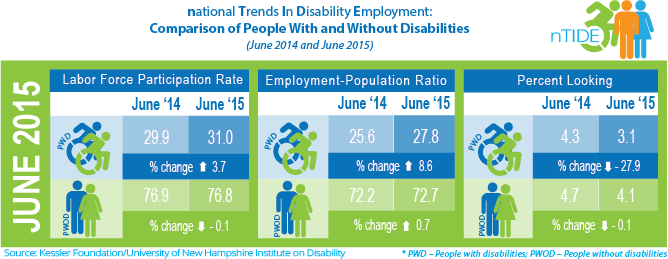nTIDE June 2015 Jobs Report: Growing Employment Opportunities for People with Disabilities
Kessler Foundation and University of New Hampshire release June nTIDE Report – Monthly Update
WEST ORANGE, N.J. – July 2, 2015. While employment gaps still exist, Americans with disabilities are engaging in the workforce at a faster rate than Americans without disabilities, according to today's National Trends in Disability Employment – Monthly Update (nTIDE), issued by Kessler Foundation and University of New Hampshire’s Institute on Disability (UNH-IOD). Strategies that boost employment for people with disabilities are being implemented across the nation. Faith communities, for example, are well positioned to connect people and employers within their congregations.
In the Bureau of Labor Statistics’ Jobs Report released Thursday, July 2, the employment-to-population ratio for working-age people with disabilities increased from 25.6 percent in June 2014 to 27.8 percent in June 2015 (up 8.6 percent; 2.2 percentage points). For working-age people without disabilities, the employment-to-population ratio also increased slightly from 72.2 percent in June 2014 to 72.7 percent in June 2015 (up 0.7 percent; 0.5 percentage points). The employment-to-population ratio, a key indicator, reflects the percentage of people who are working relative to the total population (the number of people working divided by the number of people in the total population multiplied by 100). In comparison to June 2014, 537,000 more Americans with disabilities are in the workforce.
“Over the past nine months, more Americans with disabilities are becoming employed relative to the same time last year,” according to John O’Neill, Ph.D., director of employment and disability research at Kessler Foundation. “These gains for people with disabilities continue to exceed gains made by people without disabilities.This is indeed good news as we prepare to celebrate the twenty-fifth anniversary of the Americans Disabilities Act.”
For people with disabilities, the labor force participation rate also increased from 29.9 percent in June 2014 to 31.0 percent in June 2015 (up 3.7 percent; 1.1 percentage points). For people without disabilities, the labor force participation rate decreased slightly from 76.9 percent in June 2014 to 76.8 percent in June 2015 (down 0.1 percent; 0.1 percentage points). The labor force participation rate is the percentage of the population that is working or actively looking for work.
“For so many years—decades—the growth in employment for people with disabilities has lagged well behind that of people without disabilities,” said Andrew J. Houtenville, Ph.D., associate professor of economics and research director at UNH-IOD. “With each month that we see continued positive news for people with disabilities, it makes me wonder whether we are seeing a real, long-term, structural shift in employment patterns—nine months is still a relatively short period of time, but it’s better than seeing the opposite trend.”

Networking with family and friends is a strategy that the majority of people with disabilities use successfully when preparing for work (62.4 percent) and while actively job hunting (68.1 percent), according to the recently released 2015 Kessler Foundation National Employment & Disability Survey. Initiatives that unite community organizations toward the goal of employment are broadening the scope of networking and expanding the opportunities to connect job seekers and employers. One such program is Putting Faith to Work, a program funded by Kessler Foundation that utilizes the networks of faith communities. The program’s lead site isthe Vanderbilt Kennedy Center at Vanderbilt University.
Based on a successful pilot in Minnesota, networks are being implemented in Tennessee, Texas and Kentucky. “Putting Faith to Work connects people with disabilities with jobs by building on the inherent spiritual and emotional supports of faith communities,” said Elaine E. Katz, MS, CCC-SLP, senior vice president at Kessler Foundation. “Providing congregations with the necessary resources to help their members find meaningful work deepens the commitment of the faith community while improving the quality of life of people with disabilities. Diversity in our communities and the workplace benefits us all.”
In July 2015, among workers ages 16-64, the 4,471,000 workers with disabilities represented 3.2 percent of the total 141,240,000 workers in the U.S.
“The statistics in nTIDE are not seasonally adjusted,” noted Dr. O’Neill. “Because disability employment data have been collected for so few years, more time is needed for seasonal trends to become evident.”
The next nTIDE will be issued on Friday, August 7, 2015.
NOTE: The statistics in the National Trends in Disability Employment – Update are based on Bureau of Labor Statistics numbers, but are NOT identical. They have been customized by the University of New Hampshire to efficiently combine the statistics for men and women of working age (16 to 64).
nTIDE is funded, in part, by grants from the National Institute on Disability, Independent Living and Rehabilitation Research (NIDILRR) (H133B130015 & H133B120005) and Kessler Foundation.
About Kessler Foundation
Kessler Foundation, a major nonprofit organization in the field of disability, is a global leader in rehabilitation research that seeks to improve cognition, mobility and long-term outcomes, including employment, for people with neurological disabilities caused by diseases and injuries of the brain and spinal cord. Kessler Foundation leads the nation in funding innovative programs that expand opportunities for employment for people with disabilities.
About the Institute on Disability at the University of New Hampshire
The Institute on Disability (IOD) at the University of New Hampshire (UNH) was established in 1987 to provide a coherent university-based focus for the improvement of knowledge, policies, and practices related to the lives of persons with disabilities and their families. For information on the NIDILRR-funded Employment Policy and Measurement Rehabilitation Research and Training Center, visit http://www.ResearchonDisability.org.
For more information, or to interview an expert, contact:
Lauren Scrivo, 973.768.6583, [email protected]
Carolann Murphy, 973.324.8382, [email protected]